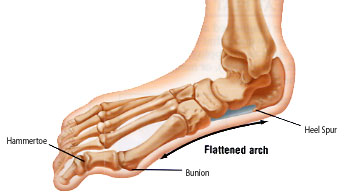Flat Feet

What are ‘flat feet’?
In a standing position, the inside of the foot should be raised slightly; this is called the arch of the foot. The height of this arch varies amongst individuals. Where a person has a very low arch or no arch at all, this is referred to as flat feet, fallen arches or ‘pronated’ feet. When someone with flat feet stands, their inner foot or arch flattens and the foot often rolls over onto the inner side, therefore, the sole of the foot is fully touching the ground. Some people do not have any problems with this foot shape, however, it can lead to problems in the feet, ankles, knees, hips and back due to the overstraining of the ligaments and muscles.
What are the symptoms of flat feet?
Symptoms depend greatly on the severity of the condition. Often people find that their foot is ‘rolling inwards’ or collapsing (known as over-pronating). Common areas for pain are; the inner side of the ankle, the arch of the foot and in the heel, calf, knee, hip and back.
What are the causes of flat feet?
Often flat feet run in families. You may find that there is an arch present when sitting but when standing the arch may completely flatten and make the leg feel like it is rolling inwards. A number of things can cause the feet to flatten in later life; injury, arthritis, a ruptured tendon and diseases of the nervous system.
What should I do if I have flat feet?
If there is no pain present with the condition it is not necessary to do anything. If pain occurs during activity, such as sport, or is a part of everyday life, certain treatment options are available. An assessment with your podiatrist is necessary to identify the severity of the condition and the appropriate treatment.
What shouldn’t I do if I have flat feet?
Higher levels of activity often make this condition worse, for example running on hard ground. Continuing with this activity can put excessive stress on ligaments, tendons and muscles and should, therefore, be avoided until treatment has been sought. High heels should be avoided as these place further strain on the foot.
Could there be any long term effects of flat feet?
Depending on the severity of your flat feet, various other complaints can develop in both the feet and legs if painful flat feet are left untreated. Flat feet can cause an inefficient style of walking and running which can overstrain ligaments and muscles. If this is repeated over a number of years, tears in these structures may occur.
Podiatry treatment for flat feet
Wearing supportive well-fitted shoes can alleviate aching in the arch of the foot. This, however, may not be adequate and you may require an insole or orthotic to support the arch and reduce the amount of collapsing (pronating). An orthotic is worn in the shoe. There are two types of orthotics, casted and non-casted. Casted orthotics are specifically made for your foot and non-casted are off-the-shelf models. Your podiatrist will recommend which type of orthotics are required.
